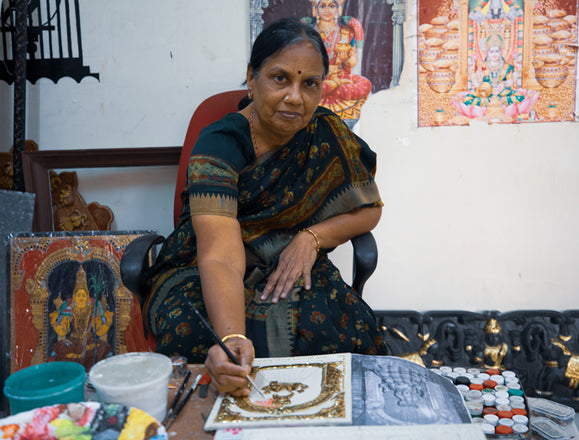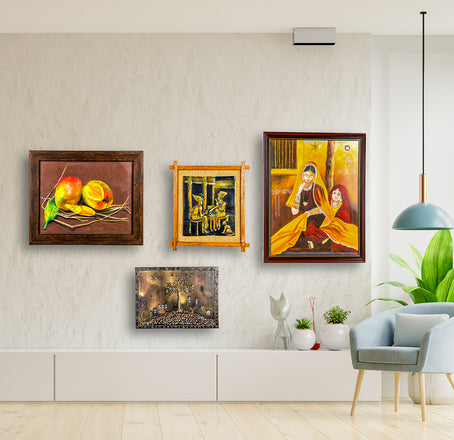
About

Vanmathi Balakrishnan
The founder Vanmathi Balakrishnan hails from Kumbakonam town in the Tanjore District. She has been trained in the traditional art form by the native artisans of the Tanjore region for several years.
Best Artist Painting

Latest Paintings Collection
Discover the World Through Original Paintings For Sale
Testimonials

Wonderful balaji tanjore painting that gives divine look to my pooja room.
– Mithra

Bought a beautiful customized painting. Awesome collections and great customer service.
– Mayank Pandey

Had a unforgettable painting at my home that gives luxurious look. Thanks to Mangala Arts and its artists.
– Shaiju

A great experience with Mangala Arts Team.
– Nirmal

Shipping Policy
For Shipping details
Latest Blog
The Lesser-Known Stories Hidden in Lord Balaji Tanjore Paintings
May 14, 2025

The first glance at a Lord Balaji Tanjore painting often brings a sense of awe. The rich gold, the fine details, and the calm expression of the deity create a strong spiritual presence. But beyond the beauty, there are stories that many viewers miss—hidden meanings and quiet messages, carefully placed by skilled artists. Table of Contents 1. The Crown in Lord Balaji Tanjore Painting Stands for Cosmic Responsibility 2. The Meaning Behind the Conch and Discus 3. The Protective Hand of Perumal Thayar 4. Small Symbols in Embossed Balaji Tanjore Paintings 5. Light and the Living Presence of Balaji FAQs Why Choose Mangala Tanjore Paintings Conclusion Each Perumal Tanjore painting is not just a picture of a God. It is a piece of history, devotion, and tradition, captured in gold and color. 1. The Crown in Lord Balaji Tanjore Painting Stands for Cosmic Responsibility One often overlooked detail in a Lord Balaji Tanjore painting is the crown or “kiritam.” It rests upon the deity’s head and appears purely ornamental to the casual eye. However, the crown carries deep spiritual meaning. It symbolizes Lord Balaji’s role as the protector of the universe and the upholder of dharma. In many embossed Balaji Tanjore paintings, this crown is crafted with extra care. Artisans use rich layers of gold foil and gemstones. But the true beauty lies in its structure. It has a pointed design that reflects the peak of Mount Tirumala. This is where the Lord is believed to reside and is a symbol of royalty. It is a reminder of his cosmic duty and divine presence. The details in the crown, such as its shape, height, and ornaments, give a silent message. They talk about spiritual leadership, eternal vigilance, and heavenly guardianship. It is the Lord’s promise to guide and protect his devotees at all times. 2. The Meaning Behind the Conch and Discus Lord Balaji is often shown holding a conch (Shankha) and a discus (Chakra). These are not just symbols—they speak about the Lord’s divine role. The Chakra stands for protection and justice, while the Shankha brings peace and well-being. In some Perumal Tanjore paintings, you may notice one of these is more clearly drawn or heavily embossed than the other. This change often reflects different moods or meanings. It is the artist’s way of showing whether the Lord’s energy is more protective or peaceful in that painting. 3. The Protective Hand of Perumal Thayar In a Perumal Thayar Tanjore painting, one of the most quietly powerful gestures is the Goddess’s hand raised in abhaya mudra—the symbol of protection, fearlessness, and assurance. This subtle gesture is more than an artistic choice; it is a spiritual signal meant to comfort and guide the devotee. Unlike more dramatic divine symbols, Thayar’s open palm is calm and grounded. It offers silent reassurance: “Do not fear, I am here.” People believe that Thayar softens the decisions of Lord Balaji with compassion. Artists who create Perumal Thayar Tanjore paintings often accentuate this gesture with fine gold detailing and delicate lines. Artists ensure that even in stillness, the Goddess’s hand speaks volumes. It is a gesture that protects not just the home where the painting hangs, but also the heart of the one who believes. 4. Small Symbols in Embossed Balaji Tanjore Paintings One of the most special parts of an embossed Balaji Tanjore painting is the detailed gold work. Inside these golden layers, you might find very small symbols: a swan, a parrot, or even a tortoise. These symbols are not there by accident. The swan represents purity. The parrot is believed to be a divine messenger. The tortoise is a reference to Lord Vishnu’s Kurma avatar. These little signs tell big stories if we pay attention. 5. Light and the Living Presence of Balaji Tanjore paintings were created to be seen in temple light—soft, warm light from lamps or diyas. When a Lord Balaji Tanjore painting is placed in such light, the gold reflects beautifully. The arch seems to glow. The eyes may shine gently. It gives a feeling that the image is alive. This effect was carefully planned by the artists. The use of gold foil and raised work is not only for decoration—it is made to create a sense of presence and connection with the divine. FAQs About Lord Balaji Tanjore Paintings 1. What makes a Perumal Tanjore painting different from other spiritual artworks? Perumal Tanjore paintings use 22k gold foil and traditional techniques to create a detailed, sacred image that reflects both faith and heritage. 2. Is the embossing in Balaji Tanjore paintings only for decoration? No. The embossed gold work often highlights meaningful symbols and adds depth to the painting, both visually and spiritually. 3. How does the Thayar figure change across different Tanjore paintings? Changes in lotus color, dress, or posture can reflect different messages—such as blessings for prosperity, peace, or both. 4. Can I request a custom Perumal Thayar Tanjore painting? Yes. Many skilled artists can include personal elements or specific themes while keeping the sacred nature of the artwork. 5. Why is lighting important when displaying a Tanjore painting? These paintings are designed to glow under traditional lighting. The gold shines, and the artwork comes to life in a soft, spiritual way. Conclusion Every Lord Balaji Tanjore painting has in it more than what the eyes can see. Symbols, colors, and gold all tell quiet stories of faith and spiritual strength. Artists create these Tanjore paintings with a lot of care, devotion, and quite a deep understanding of the divine. When you see a Perumal Tanjore painting, take a moment and look closer at it. You will find that it speaks to you. The medium is not in words, but in light, gold, and silence. For a true connection to tradition and devotion, visit us online at Mangala Tanjore Paintings. Each Perumal Thayar Tanjore painting and embossed Balaji Tanjore painting is carefully crafted with high-quality materials and deep spiritual thought. When you buy from Mangala Tanjore Paintings, you are not just buying a painting. You are bringing home a sacred symbol, a piece of divine storytelling, and a timeless work of art.
5 Must-Know Tips Before Buying a Lord Balaji Tanjore Painting
May 08, 2025

When you're standing in front of a Perumal Tanjore painting, you're not just staring at colors trapped in wood. You're standing before a portal of divinity. Lord Balaji doesn't just gaze at you; he sees you. But before you bring one of these sacred marvels home, hold your horses and gather your thoughts. These aren't just any paintings. They're time travelers, storytellers, and keepers of spiritual secrets. Table of Contents 1. Eye Contact with Divinity 2. Gold That Glows in Balaji Tanjore paintings 3. Embossing That Elevates Perumal Tanjore Paintings 4. Frame the Perumal Tanjore Painting Like a Throne 5. Tradition Woven with Today FAQs Conclusion Let's unwrap the mystery and prepare you to choose your very own lord Balaji Tanjore painting—the right way. 1. Eye Contact with Divinity The eyes in a Perumal Tanjore painting are everything. Those calm, almond-shaped eyes are not just painted—they feel alive. They should meet your eyes and stay there. If the painting doesn't make you feel noticed, it's not complete. The spirit of Lord Balaji lives in those eyes. Whether you like a gentle gaze or a strong, serious look, you should feel something the moment you see it. When picking a Lord Balaji Tanjore painting, start with the eyes. In old-style paintings, the eyes carry the quiet strength seen in temple walls. In newer ones, even if the colors or designs are different, the feeling in the eyes must remain. Choose the painting that pulls you in and makes you pause. That's the one with true energy. 2. Gold That Glows in Balaji Tanjore Paintings The gold in Lord Balaji Tanjore paintings is not just decoration—it's the soul of the art. But gold must shine in a soft way. If it's too bright, it looks fake. If it's dull, it feels lifeless. Good gold shines gently, like a prayer said in a quiet voice. It should feel warm and peaceful, not loud or showy. In embossed Balaji Tanjore paintings, gold is used with care. Artists at Mangala use real gold foil and apply it just right. This makes the painting strong and long-lasting. The amount of gold and how it's added changes how the painting looks and lasts. You're not just buying a picture—you're bringing home a sacred piece. 3. Embossing That Elevates Perumal Tanjore Paintings In embossed Balaji Tanjore paintings, the raised parts make all the difference. The crown, the jewels, and the shape of Lord Balaji should feel like they're rising from the painting. You might even want to touch them. It's not just for looks—it gives the painting a powerful feel, like a tiny temple on your wall. A great Perumal Tanjore painting uses embossing in the right way. Every raised area—the necklace, the glow around the head, the special marks—should feel clean and clear. These parts make the god look real and close. If the painting makes you feel like you're standing at the steps of a temple, it's something truly special. 4. Frame the Perumal Tanjore Painting Like a Throne A good Perumal Thayar Tanjore painting needs a strong, beautiful frame. Think of the frame like a throne—it should be royal. A plastic or cheap-looking frame takes away the power of the painting. Wood frames, carved or with an antique look, are the best. They bring respect and warmth to the artwork. When Perumal and Thayar are shown together, their frames must match in style and color. The pair should look balanced and united. The frame should hold the art with grace, like how a temple holds its god. A good Lord Balaji Tanjore painting doesn't just sit in its frame—it shines from it. 5. Tradition Woven with Today Old traditions can still feel new. The best Lord Balaji Tanjore paintings keep the old temple style but also fit into modern homes. You might see softer colors like light blue, cream, or gentle green instead of bright red or deep blue. These changes help the painting feel right in your home or prayer space. Look for artists who mix the past with the present in a careful way. Maybe the gold is a little softer, or the shapes are a bit smoother. In Perumal Thayar Tanjore paintings, this mix is very important. You want to feel the spirit of yesterday, but also see a touch of today. It's not about losing history—it's about keeping it alive in a new way. FAQs 1. What makes an embossed Balaji Tanjore painting special? The embossed texture adds depth and sacred vibes, making the artwork feel three-dimensional and alive. 2. Can I hang a Perumal Tanjore painting in my living room? Absolutely. Many modern collectors hang them in living rooms, entryways, or meditation areas for spiritual energy. 3. How do I know if the gold foil is authentic? Genuine Tanjore paintings use 22-karat gold foil. Ask the artist or seller for details. Mangala's pieces always disclose their materials. 4. What's the difference between Perumal Tanjore and Perumal Thayar Tanjore paintings? The former features Lord Balaji alone, while the latter includes both Balaji and Goddess Thayar, symbolizing divine union and prosperity. 5. Are these paintings good as gifts? Yes, especially for weddings, housewarmings, or festivals. They carry grace, meaning, and visual splendor. Conclusion A Lord Balaji Tanjore painting holds your gaze, listens to your prayers, and brings home a slice of Tirumala in wood and gold. Let your heart decide, but let your eyes choose wisely. Discover Mangala's curated collection of Perumal Tanjore painting masterpieces and embossed Balaji Tanjore paintings. Whether you seek timeless devotion or a modern touch on a sacred classic, there's a work waiting for you at Mangala Tanjore Paintings. Let Lord Balaji and Thayar grace your home today.









